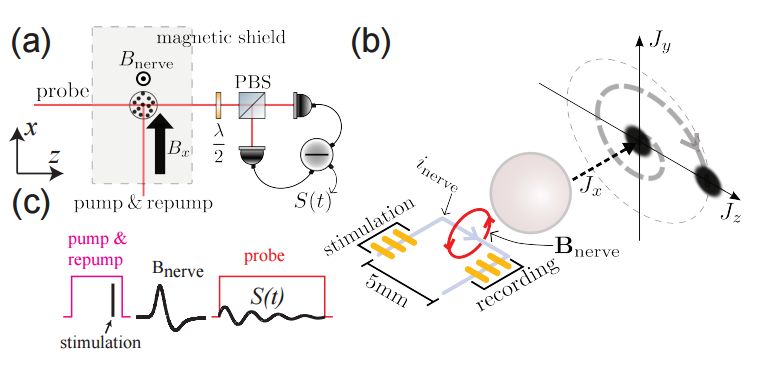First Laser Measurements of Magnetic Fields of Single Nerves
Biologists have known that nerves produce and respond to electrical signals since the 18th century, when Luigi Galvani discovered that the muscles in a frog’s leg twitch when stimulated by a spark.

However, the systematic study of the electrical signals that nerves produce had to wait until the early 20th century for the development of sensitive electrical recording equipment such as the cathode ray oscilloscope.
This development revolutionized the understanding of nervous function. The ways nerves conduct signals can be a powerful indicator for diseases such as multiple sclerosis and can even detect certain types of intoxication.
And yet the method has some drawbacks. For example, measuring electrical signals in nerves by inserting a needle-like electrode is somewhat invasive, and the mere act of attaching an electrode to a nerve can change the signal, making the results hard to interpret. So neuroscientists have long hoped for a noninvasive technique that could do the job instead.
That may be about to happen thanks to the work of Kasper Jensen at the University of Copenhagen in Denmark and a few pals who have developed a way to easily measure the magnetic fields associated with electrical signals in nerves. The technique could pave the way for a new generation of diagnostic tools for spotting diseases linked to nervous function and for understanding the basic function of nerves.
First, some basics. When a nerve fires, it sends an electrical signal called an action potential along its length. This electrical pulse also generates a magnetic field. Scientists have been able to measure this pulse since the 1980s using SQUID magnetometers that need to be carefully cooled to superconducting temperatures.
The sensing part of the device is a tiny coil through which the nerve has to run. So this technique cannot be used for in vivo measurement. And although these devices have become more practical, they still rely on superconducting technology which is costly to translate into a clinical setting.
So a way of measuring these magnetic fields at a distance and at room temperature would be hugely useful. And that’s exactly what Jensen and co have done.
These guys have built a sensor that uses a laser beam to detect the effect of a magnetic field on gaseous caesium atoms, which polarize light when they are magnetized. So-called optical magnetometers are hugely powerful devices that are limited in sensitivity only by quantum effects such as the quantum shot noise of light.
That’s important because, at least in theory, it allows them to detect the fields associated with nerves at a distance of several millimeters. So they can sit outside the body while measuring a field produced inside it.
There’s another important advantage. Optical magnetometers work perfectly well at room temperature and even better and body temperature. The sensors are also small—just a few millimeters across—so they are ideal for clinical settings. Indeed, they have been used on various occasions for just this purpose.
However, until now, these clinical devices have never worked at the quantum limit and so have not been sensitive enough to detect the fields from individual nerve fibers.
The breakthrough that Jensen and co have achieved is to operate an optical magnetometer at the quantum limit at room temperature for the first time in this biological setting.
Jensen and co put the device through its paces by sensing the magnetic fields generated by frog sciatic nerves from a few millimeters away. This field turns out to be in the region of a few picoTesla but sub-picoTesla measurements are possible. By comparison, the Earth’s magnetic field is some three orders of magnitude stronger.
The device can operate continuously which allowed the team to measure the shape of the magnetic field generated by the nerve as it is stimulated. “We have performed noninvasive detection of nerve impulses from the frog sciatic nerve by measuring the magnetic field generated by the nerve with a room-temperature sensor with near quantum limited sensitivity,” say Jensen and co.
That’s interesting work that will have important applications in medical diagnostics. “The magnetometer [is] perfect for medical diagnostics in physiological/clinical areas such as cardiography of fetuses, synaptic responses in the retina, and magnetoencephalography,” say the team.
It surely won’t be long before this team, or another, begins to make just these kinds of measurements in human subjects. So it’s just possible that this development will have a similar impact on the study of nerve conduction as the development of sensitive electrical recording equipment in the 1920s.
Ref: arxiv.org/abs/1601.03273 : Non-Invasive Detection of Animal Nerve Impulses with an Atomic Magnetometer Operating Near Quantum Limited Sensitivity
Keep Reading
Most Popular
Large language models can do jaw-dropping things. But nobody knows exactly why.
And that's a problem. Figuring it out is one of the biggest scientific puzzles of our time and a crucial step towards controlling more powerful future models.
The problem with plug-in hybrids? Their drivers.
Plug-in hybrids are often sold as a transition to EVs, but new data from Europe shows we’re still underestimating the emissions they produce.
Google DeepMind’s new generative model makes Super Mario–like games from scratch
Genie learns how to control games by watching hours and hours of video. It could help train next-gen robots too.
How scientists traced a mysterious covid case back to six toilets
When wastewater surveillance turns into a hunt for a single infected individual, the ethics get tricky.
Stay connected
Get the latest updates from
MIT Technology Review
Discover special offers, top stories, upcoming events, and more.